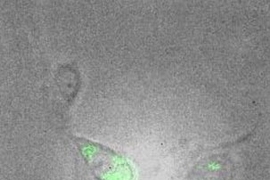The sensors, made of carbon nanotubes wrapped in DNA, can detect chemotherapy drugs such as cisplatin as well as environmental toxins and free radicals that damage DNA.
"We've made a sensor that can be placed in living cells, healthy or malignant, and actually detect several different classes of molecules that damage DNA," said Michael Strano, associate professor of chemical engineering and senior author of a paper on the work appearing in the Dec. 14 online edition of Nature Nanotechnology.
Michael Strano and Daniel Heller discuss a new nanosensor and its applications.
Video: Anne Trafton/MIT News Office
Such sensors could be used to monitor chemotherapy patients to ensure the drugs are effectively battling tumors. Many chemotherapy drugs are very powerful DNA disruptors and can cause serious side effects, so it is important to make sure that the drugs are reaching their intended targets.
"You could figure out not only where the drugs are, but whether a drug is active or not," said Daniel Heller, a graduate student in chemical engineering and lead author of the paper.
The sensor can detect DNA-alkylating agents, a class that includes cisplatin, and oxidizing agents such as hydrogen peroxide and hydroxyl radicals.
Using the sensors, researchers can monitor living cells over an extended period of time. The sensor can pinpoint the exact location of molecules inside cells, and for one agent, hydrogen peroxide, it can detect a single molecule.
The new technology takes advantage of the fact that carbon nanotubes fluoresce in near-infrared light. Human tissue does not, which makes it easier to see the nanotubes light up.
Each nanotube is coated with DNA, which binds to DNA-damaging agents present in the cell. That interaction between the DNA and DNA disruptor changes the intensity and/or wavelength of the fluorescent light emitted by the nanotube. The agents produce different signatures that can be used to identify them.
"We can differentiate between different types of molecules depending on how they interact," Strano said.
Because they are coated in DNA, these nanotube sensors are safe for injection in living cells. (Nanotubes can come in many different lengths and can be coated with different materials, which influences whether they are safe or toxic, Strano said.)
In future studies, the researchers plan to use the sensors to study the effects of various antioxidants, such as the compounds in green tea, and learn how to more effectively use toxic chemotherapy drugs.
Other authors of the paper include MIT graduate student Hong Jin of the Department of Chemical Engineering. Researchers from the University of Illinois at Urbana-Champaign also contributed to the work, which was funded by the National Science Foundation.
A version of this article appeared in MIT Tech Talk on December 17, 2008 (download PDF).









